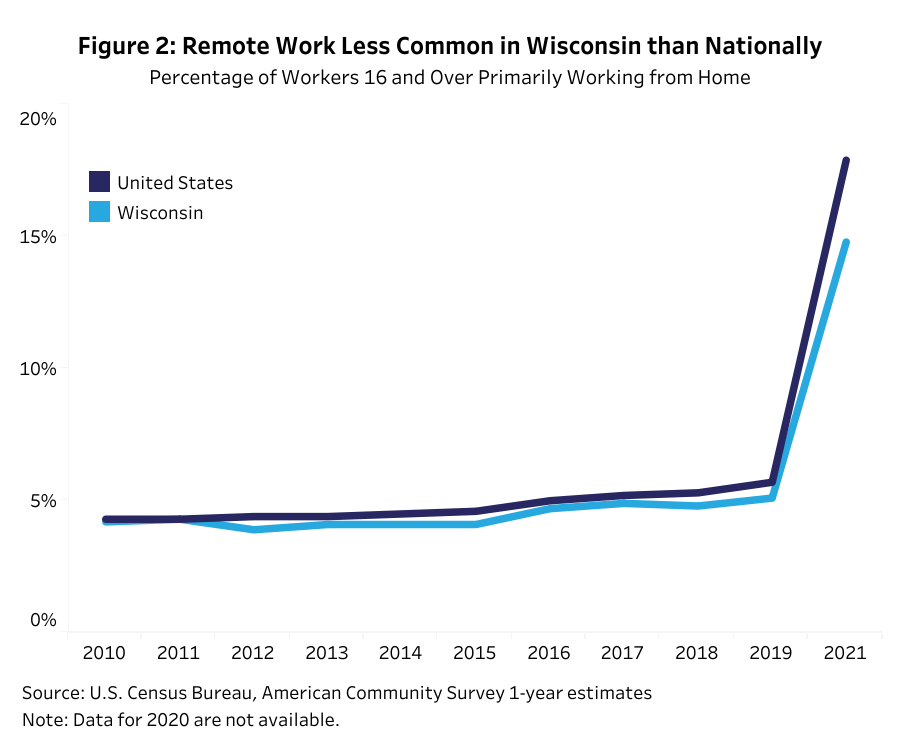In October, corporate employees at Kohl’s Corp. will be required to return to the office for at least four days a week.
It’s the latest high-profile Wisconsin company to announce measures to bring employees back to the office after the pandemic expanded remote work options for many office workers. The move comes as work from home options remain popular nationally.
Kohl’s says the new policy will only affect employees who live within 30 miles of the company’s headquarters in Menomonee Falls. Those employees will be required to be at the facility Monday through Thursday, with the option to work remotely on Fridays.
News with a little more humanity
WPR’s “Wisconsin Today” newsletter keeps you connected to the state you love without feeling overwhelmed. No paywall. No agenda. No corporate filter.
Employees returning to the office will also be given two “work from anywhere” weeks each year. Kohl’s notified employees of the upcoming change last week, and says the move is designed to increase “connection and collaboration” among employees.
“We’ve been intentional in creating a workspace our associates can love,” a statement from the company reads. “Our building features Bartolotta-run food services, a full Wellness Center that includes great health care services, a CVS pharmacy and a WAC fitness center, an on-site daycare, and collaborative workspaces throughout the building.”
But the move hasn’t exactly been embraced among all corporate employees. One worker who will be required to return to the office spoke to WPR on the condition of anonymity.
The Kohl’s employee said they’ve been working in a hybrid environment for a few years and they come into the office regularly to collaborate with others. They said the new mandate came as a shock.
“For a lot of people, it means less time with their families,” the employee said. “I think for the bulk of us, we work so that we can have our lives outside of work and have time with our families. It’s just really disappointing, and it’s going to be really, really hard on a lot of people.”
One of the big frustrations, the employee said, is that it’s not entirely clear to workers why they need to return to the office because teams are already working collaboratively.
“The reasoning we have been given is collaboration, and, absolutely, that’s something that is important to our jobs,” they said. “But I think we all feel that having that balance of in office and at home, we connect as teams, we have collaborative days.”
Despite the return to office policy, the employee also said they plan to stay with the company because they enjoy their job.
Remote work by the numbers
Approximately 21.7 percent of American workers 25-years-old or older worked remotely at least some of the time as of October 2023, according to the U.S. Bureau of Labor Statistics. That’s broken down into 11.2 percent working remotely all the time and 10.5 percent working remotely some of the time.
By 2025, Forbes reports that the share of remote workers is expected to increase slightly to about 22 percent of the workforce. The magazine also reports that 98 percent of workers want to work remotely at least some of the time.
Wisconsin has typically lagged a bit behind the country in terms of the share of workers in the state doing their jobs remotely. In 2021, roughly 17.9 percent of U.S. workers did their jobs from home compared to 14.8 percent of Wisconsin workers, according to the Wisconsin Policy Forum.
There have been signs that remote work has declined in the state since 2021. From 2021 to 2022, the state saw an 11 percent decrease in the number of people working remotely, from 437,295 to 387,700, according to a recent study from LLC.org.

Remote workers in Wisconsin weigh in
Stevens Point resident Bob Cummings works a hybrid schedule as a computer programmer for Mid-State Technical College. He spends three days working from home and two days in the office each week.
Cummings said he chooses to work in the office those days because he wants to keep a rapport with his teammates. But he also enjoys working from home, saying he likes that he can keep his windows open, choose the music he listens to and have the chance to get snacks from his kitchen.
“As much as I think those conversations with my co-workers are important, I get three days without them so I can really focus on my work and what I’m doing,” he said. “Plus no commute, of course, and I have my office set up the way I want.”
Beaver Dam resident Melinda Pearson works remotely for a Canadian water slide company. She said working remotely allows her to work both at her home in Beaver Dam and at her cottage in the town of Pickerel. She said it also allows her to spend more money in those rural communities.
“That’s growing these smaller towns, where I wouldn’t be able to find a job in my field with the salary I make,” she said. “I really do think it helps to bring money back into these smaller communities.”
Bayfield County resident Jeremy McCormick works remotely for a lab in California. McCormick said he doesn’t miss in-person interactions with coworkers.
“I can really concentrate well because there’s no one that’s kind of coming around and bothering me in-person if that makes sense,” he said. “I do end up interacting with people a lot though, through Zoom and other tools like that.”
All three of the remote workers said they feel that they have a better work-life balance now than they did earlier in their careers when working in the office was the norm.
Pearson and Cummings both also said that if their employers hypothetically required them to return to the office full-time, they’d dust off their resumes and start looking for other employment.
“If my company said, ‘Look, we’re only going to employ people that can be in the office.’ If it was an option for me to come into the office, I would look for other employment,” said Pearson. “I really do enjoy working at home, I think you’re removed a little bit from office politics. I personally am more productive.”

Are there benefits to returning to the office?
Officials with the Greater Madison Chamber of Commerce and the Metropolitan Milwaukee Association of Commerce said remote work does have some drawbacks for employers, workers and local economies.
Zach Brandon, president of the Greater Madison Chamber of Commerce, said it’s harder to build a sense of company culture in a remote work environment than in an office environment, and there are some signs that remote work can hinder innovation.
“At its core innovation comes from human interaction and, candidly, human friction,” he said. “Some of the best stories about where innovation comes from how it develops are people engaging with each other directly at a human level. Not that it can’t be done with technology, but we have to acknowledge that technology filters something out.”
He also said remote workers can sometimes be overlooked by employers when it comes to advancement opportunities.
While downtown Milwaukee has seen a relatively strong rebound from the pandemic, Dale Kooyenga, president of the Metropolitan Milwaukee Association of Commerce, said remote work can have unintended side effects for small businesses around offices.
“You can’t enjoy good beer and have a healthy salad (at a local business) over Zoom,” he said. “You need to have that traffic of people that go into a region where there’s employees to have those businesses. If you don’t have that, you have another part of the economy that suffers.”
Wisconsin Public Radio, © Copyright 2025, Board of Regents of the University of Wisconsin System and Wisconsin Educational Communications Board.







